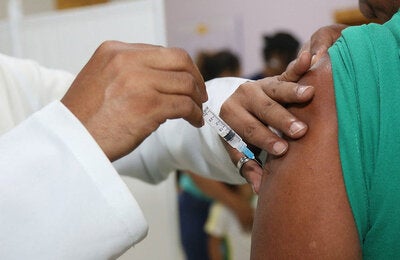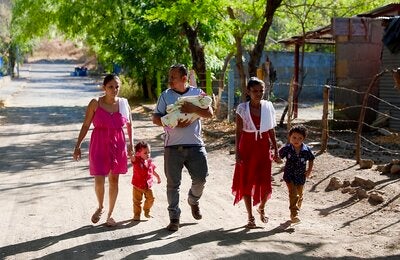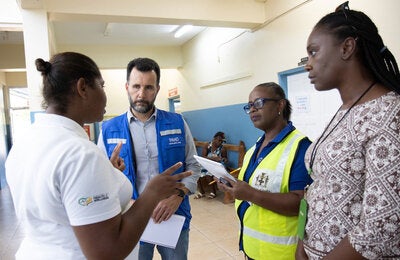
![]() For Haiti's health sector, 2010 was a year of unprecedented challenges. The January 12 earthquake claimed the lives of more than 200,000 Haitians, including some 300 health workers, and injured many thousands more, while causing serious damage and disruption to health infrastructure, services and supply lines. The cholera epidemic added new difficulties just as the health sector was beginning to recover and rebuild.
For Haiti's health sector, 2010 was a year of unprecedented challenges. The January 12 earthquake claimed the lives of more than 200,000 Haitians, including some 300 health workers, and injured many thousands more, while causing serious damage and disruption to health infrastructure, services and supply lines. The cholera epidemic added new difficulties just as the health sector was beginning to recover and rebuild.
With support from partners, Haiti's health sector makes progress
 For Haiti's health sector, 2010 was a year of unprecedented challenges. The January 12 earthquake claimed the lives of more than 200,000 Haitians, including some 300 health workers, and injured many thousands more, while causing serious damage and disruption to health infrastructure, services and supply lines. The cholera epidemic added new difficulties just as the health sector was beginning to recover and rebuild. In spite of all this, ministry officials, health professionals, and volunteers worked to overcome obstacles and made important progress toward recovery.
For Haiti's health sector, 2010 was a year of unprecedented challenges. The January 12 earthquake claimed the lives of more than 200,000 Haitians, including some 300 health workers, and injured many thousands more, while causing serious damage and disruption to health infrastructure, services and supply lines. The cholera epidemic added new difficulties just as the health sector was beginning to recover and rebuild. In spite of all this, ministry officials, health professionals, and volunteers worked to overcome obstacles and made important progress toward recovery.
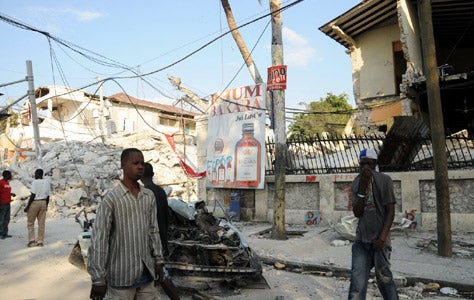 Despite the destruction of its headquarters and the loss of key personnel, Haiti's Ministry of Health developed and began implementing a strategy to rebuild the health system, as part of the government's larger Action Plan for National Recovery and Development of Haiti. This included plans to rebuild 30 of the existing 49 hospitals in the three departments most heavily affected by the earthquake, and to guarantee free health care to the country's most vulnerable groups.
Despite the destruction of its headquarters and the loss of key personnel, Haiti's Ministry of Health developed and began implementing a strategy to rebuild the health system, as part of the government's larger Action Plan for National Recovery and Development of Haiti. This included plans to rebuild 30 of the existing 49 hospitals in the three departments most heavily affected by the earthquake, and to guarantee free health care to the country's most vulnerable groups.
Following the outbreak of cholera in late October, healthcare providers worked tirelessly day and night to save lives and care for the ill, despite lack of experience with the new disease. Haiti's international partners-including U.N. agencies and international NGOs-provided invaluable support, augmenting the staff of hospitals and other health facilities with trained volunteers.
One year after Haiti's earthquake
List of commemorative events
Following the initial outbreaks, Haiti's Ministry of Health launched a national strategy to respond to the epidemic, with initiatives to protect families at the community level, strengthen primary health care centers across the nation, and establish a network of cholera treatment centers and specialized hospital units to treat severe cases.
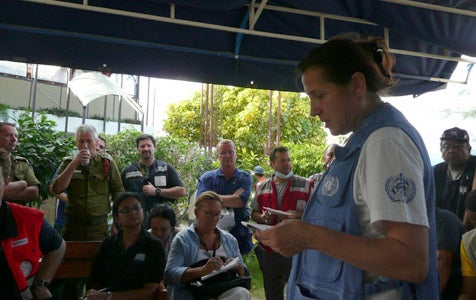 A key challenge was coordinating the more than 400 organizations and agencies participating in the health response to the earthquake and the cholera epidemic. PAHO/WHO worked closely with the Ministry of Health to coordinate these partners and to ensure the effective and efficient deployment of staff and supplies.
A key challenge was coordinating the more than 400 organizations and agencies participating in the health response to the earthquake and the cholera epidemic. PAHO/WHO worked closely with the Ministry of Health to coordinate these partners and to ensure the effective and efficient deployment of staff and supplies.
In addition to addressing the acute healthcare needs created by the cholera epidemic, the Health Cluster also helped restart critical public health programs that were interrupted by the earthquake. These included programs for outbreak control and environmental health, immunization, maternal and neonatal health, nutrition, gender-based violence, HIV, tuberculosis, malaria, dengue, mental health, health services delivery, and rehabilitation services for disabled people. In addition, Health Cluster partners participated in assessment missions, organized and managed medical supplies distribution, provided expertise to epidemiological monitoring sites, and helped distribute weekly epidemiology reports.
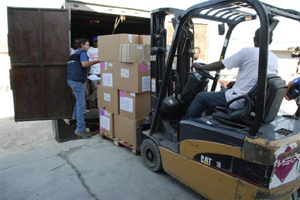 Haitian health workers have proven to be the driving force in reconstructing Haiti's health sector. They worked under the most trying of conditions, ranging from the loss of their loved ones and homes to security threats. Despite adversity, they have worked tirelessly to treat the ill and they remain at the forefront of efforts to rebuild their country.
Haitian health workers have proven to be the driving force in reconstructing Haiti's health sector. They worked under the most trying of conditions, ranging from the loss of their loved ones and homes to security threats. Despite adversity, they have worked tirelessly to treat the ill and they remain at the forefront of efforts to rebuild their country.
Additional progress toward the reconstruction of Haiti's health sector in 2010 included:
- Days after the earthquake, the Ministry of Health, with support from PAHO/WHO, established a surveillance system for six critical communicable diseases: measles, diphtheria, meningitis, acute hemorrhagic fever syndrome, flaccid paralysis and rabies. The system collects data and provides analysis based on weekly reporting from 52 sites. Building on this effort, in November an early warning system was implemented to investigate rumors of new cases and deaths and to facilitate prompt action in response.
- The Ministry of Health's medical warehouse, PROMESS, which is managed by PAHO/WHO, oversaw the distribution of quality medicines, vaccines and medical supplies to treat more than 100,000 cholera patients, in close collaboration with other Health Cluster partners. PROMESS also maintained the temperature-controlled supply chain (cold chain) for vaccines and drugs, despite fuel shortages throughout the year.
- Less than four months after the earthquake, Haiti participated in Vaccination Week in the Americas, with a launching event in Fond Parisien, near the border with the Dominican Republic. Other important vaccination achievements included the more than 980,000 vaccines administered to vulnerable groups in earthquake-affected areas, and the development of a five-year strategic plan to accelerate the introduction of the pentavalent vaccine (diphtheria-tetanus-pertussis-hepatitis B-Haemophilus influenzae type b).
- With PAHO/WHO support, the Ministry of Health implemented in June 2010 a system to provide free health care for children under 5, known as Soins Infantiles Gratuits (SIG). The system provides free services through an agreement with the 27 largest public and private hospitals, which receive funds for training of health workers, development of triage centers, purchase of medication, and the organization of the pediatric services.
- The free obstetric care program (Soins Obstétricaux Gratuits or SOG ) resumed its activities soon after the earthquake, and expanded the range of services provided to pregnant women in 2010. Currently 63 health facilities participate in the SOG program. The number of institutional deliveries in Haiti increased from 2,953 per month in 2007 to 6,828 per month in 2010. Maternal mortality rates in institutions in the SOG system are 120 deaths per 100,000 births, compared to the national estimate of 630 deaths per 100,000 births.
- PAHO/WHO developed and maintained a database of health facilities in Haiti, with an Internet-based interactive map to help coordinate health partners involved in the response. PAHO/WHO also promoted wider use of LSS/SUMA (Logistics Support System), which provides national authorities, United Nations agencies, and other coordinating bodies with details on goods and supplies pledged and distributed in the emergency.
- Improved case management of cholera has helped reduce the case fatality rate from a high of 9 percent at the start of the epidemic to an average 2.1 percent nationwide. This was made possible by the establishment of 87 cholera treatment centers and 162 cholera treatment units (smaller units associated with existing health facilities), the distribution of oral rehydration salts in thousands of communities, training for health workers using updated protocols for cholera prevention and control, and the training and deployment of 10,000 community health agents.
These achievements of the national health services were only possible due to the contributions of hundreds of NGOs, several bilateral health institutions, such as the US CDC and the Cuban Medical Mission, and many national and provincial bilateral cooperation agencies.
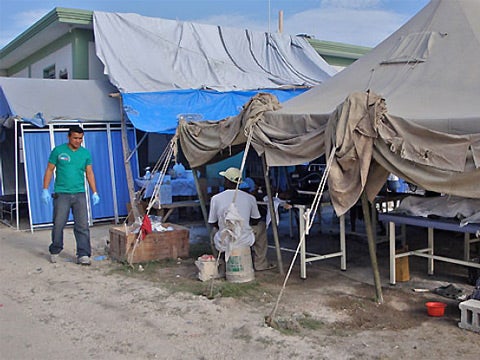 Successful reconstruction of the country's health sector will also require that both health and non-health partners contribute to the development of a strong, self-reliant, and sustainable Haitian health sector, in addition to providing jobs and opportunities for other Haitians.
Successful reconstruction of the country's health sector will also require that both health and non-health partners contribute to the development of a strong, self-reliant, and sustainable Haitian health sector, in addition to providing jobs and opportunities for other Haitians.
Toward that end, Health Cluster partners have agreed to the following objectives for 2011 and beyond:
- Ensure access to free of charge basic health services for the population directly or indirectly affected by the cholera outbreak.
- Strengthen surveillance systems to be able to identify trends in disease occurrence and outbreak control, including for the ongoing cholera epidemic.
- Scale up community mobilization and health promotion.
- Provide rapid operational response to cholera-affected communities.
- Support the Ministry of Health in coordinating the cholera response.
- Strengthen environmental health programs, including water quality and health promotion.
- Improve Health Cluster coordination for more effective service delivery and information sharing.
- Provide timely and appropriate response to disasters and public health emergencies, including contingency planning.
- Strengthen and increase coverage of HIV-related services.
Another critical objective is to improve sanitary conditions. Lack of access to safe water, improper sanitation, unsafe food handling in markets and open-air diners, poor management of dead bodies, and improper disposal of human waste and garbage all remain critical problems. Initiatives in all these areas, which involve not only health but also other key sectors such as water and sanitation, are vital for Haiti to control the cholera epidemic and improve health conditions.
PAHO/WHO has a long-term commitment to Haiti and will continue to help coordinate recovery efforts, provide technical cooperation, and strengthen national leadership, with a focus on promoting equity in health, combating disease, and improving the quality of life for the Haitian people.
Links
Multimedia
- One year One team 4Haiti (video)
- One year One Team 4Haiti (photo essay)
- PAHO Haiti blog
Press Releases

